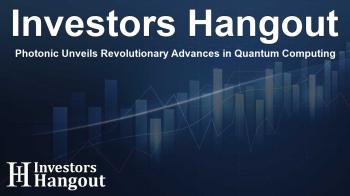Photonic Unveils Revolutionary Advances in Quantum Computing

Photonic’s Breakthrough in Quantum Computing Technology
Photonic Inc. has marked a significant milestone in quantum computing by introducing innovative low-overhead Quantum Low-Density Parity Check (QLDPC) codes. This achievement is set to accelerate the timeline towards practical quantum computing, addressing one of the significant challenges in the industry: error correction.
The Challenge of Error Correction in Quantum Computing
Quantum computers rely on advanced error correction to unlock the full potential of their capabilities. Traditional surface code methods typically require millions of physical qubits to function as a much smaller number of logical qubits. This high overhead realistically delays the realization of effective quantum solutions for numerous critical computational tasks.
New Efficient QLDPC Codes
Stephanie Simmons, the Chief Quantum Officer at Photonic, explained the breakthrough, stating, "Unlocking the quantum logic of high-performance QLDPC codes has been a long-standing challenge in quantum error correction. We have now developed fast and efficient SHYPS codes that can execute all quantum algorithms using significantly fewer physical qubits—up to 20 times fewer than previous methods. This has fundamentally shifted the landscape of quantum computing.
Understanding SHYPS Codes
These SHYPS codes not only represent a new frontier in quantum technology but also provide practical solutions amid persistent limitations. By leveraging these innovative codes, Photonic has effectively reduced the required physical qubit count, enabling a more accessible path towards realizing impactful quantum applications.
The Road Ahead for Quantum Computing
According to David Shaw, Lead Analyst at Global Quantum Intelligence, the field of quantum computing will witness a significant divide: those equipped to implement the new hardware capable of running these efficient codes and those who are not. As companies rush to adapt, there will be a crucial emphasis on developing in-house expertise for quantum innovations.
The Revolutionary Nature of QLDPC Codes
QLDPC codes have been in development for over two decades, offering a substantial reduction in overhead requirements compared to traditional methods. However, researchers needed to unlock the potential for quantum logic utilizing these codes, a challenge that Photonic has successfully addressed in their latest publication.
A Technological Leap Forward
The technology behind Photonic’s new QLDPC codes has been rigorously tested through extensive simulations, proving that the proposed logic operates efficiently in practice, rather than just in theory. Such advancements herald a new era where quantum computing may no longer be a distant goal but a tangible reality.
Understanding Photonic's Contributions
Photonic Inc. stands at the forefront of quantum computing innovations, aiming to develop practical solutions for real-world challenges in various fields including materials science, pharmaceuticals, and environmental issues. Their proprietary Entanglement First™ architecture incorporates optically linked silicon spin qubits, enabling heightened connectivity essential for implementing effective QLDPC codes.
About Photonic Inc.
Headquartered in Vancouver, Photonic employs over 150 team members and collaborates with leading firms and global partners to enhance computing capabilities. The company focuses on delivering scalable quantum solutions that ensure seamless integration within existing technological frameworks, paving the way for future advancements.
Frequently Asked Questions
What are QLDPC codes?
Quantum Low-Density Parity Check (QLDPC) codes are advanced techniques used in quantum computing for effective error correction, allowing quantum computations to be more reliable.
How do SHYPS codes differ from traditional methods?
SHYPS codes can run quantum algorithms using up to 20 times fewer physical qubits compared to traditional error correction methods, significantly reducing the overhead in quantum computing.
Why is error correction critical in quantum computing?
Error correction is essential in quantum computing to ensure that calculations remain accurate despite the inherent noise and errors in quantum systems.
What challenges have researchers faced with QLDPC codes?
The primary challenge has been developing the necessary quantum logic to implement QLDPC codes efficiently and effectively, which Photonic has recently overcome.
What impact will these developments have on the industry?
These advancements are expected to accelerate the availability of practical quantum computing, enabling solutions to previously intractable problems across various industries.
About The Author
Contact Owen Jenkins privately here. Or send an email with ATTN: Owen Jenkins as the subject to contact@investorshangout.com.
About Investors Hangout
Investors Hangout is a leading online stock forum for financial discussion and learning, offering a wide range of free tools and resources. It draws in traders of all levels, who exchange market knowledge, investigate trading tactics, and keep an eye on industry developments in real time. Featuring financial articles, stock message boards, quotes, charts, company profiles, and live news updates. Through cooperative learning and a wealth of informational resources, it helps users from novices creating their first portfolios to experts honing their techniques. Join Investors Hangout today: https://investorshangout.com/
The content of this article is based on factual, publicly available information and does not represent legal, financial, or investment advice. Investors Hangout does not offer financial advice, and the author is not a licensed financial advisor. Consult a qualified advisor before making any financial or investment decisions based on this article. This article should not be considered advice to purchase, sell, or hold any securities or other investments. If any of the material provided here is inaccurate, please contact us for corrections.

